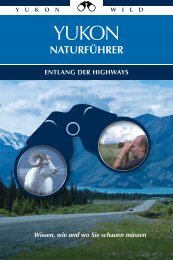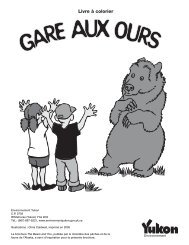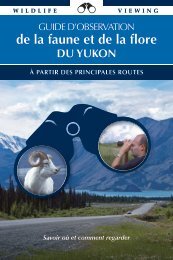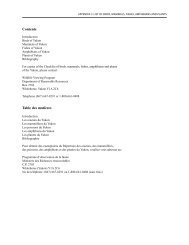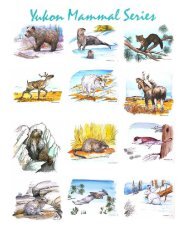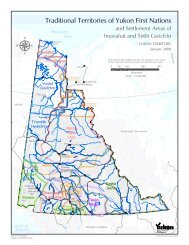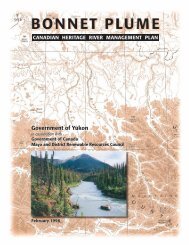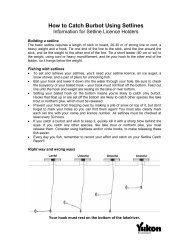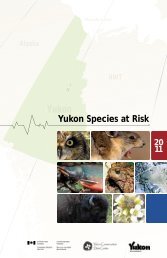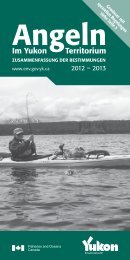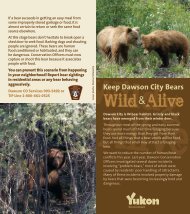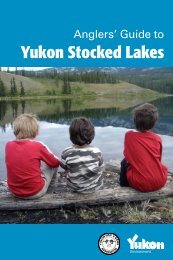Ch. 3 Land - Environment Yukon
Ch. 3 Land - Environment Yukon
Ch. 3 Land - Environment Yukon
You also want an ePaper? Increase the reach of your titles
YUMPU automatically turns print PDFs into web optimized ePapers that Google loves.
within the study area in February 1998,<br />
and some of the claim holders have<br />
let their holdings lapse. In the fall of<br />
1999, there were 75 valid quartz claims<br />
within the draft park boundary. In<br />
December 1999, the <strong>Yukon</strong> and<br />
Tr’ondëk Hwëch’in governments<br />
approved the park boundary and permanent<br />
mineral staking withdrawal will<br />
be requested.<br />
In the summer of 1999, a lapsed mineral<br />
interest was re-staked (6 claims)<br />
within an area of interest for “Goal<br />
one” protection under the <strong>Yukon</strong><br />
Protected Areas Strategy. The location<br />
of the claims within the headwaters<br />
of the Fishing Branch River, has raised<br />
concerns regarding the potential risk to<br />
water quality. In December 1999 the<br />
<strong>Yukon</strong> government approved the entire<br />
Fishing Branch watershed as a Wilderness<br />
Preserve. The existing mineral<br />
rights will be respected.<br />
Protected areas: A Canadian and<br />
Broader Perspective<br />
The Government of Canada issued a<br />
Statement of Commitment to complete<br />
Canada’s Network of Protected Areas<br />
by the year 2000. This commitment to<br />
complete a system of representative<br />
parks in each jurisdiction requires the<br />
cooperation of federal, provincial, and<br />
territorial governments 4.<br />
The <strong>Yukon</strong> still needs adequate<br />
representation in 16 of its 23 ecological<br />
regions according to the <strong>Yukon</strong> Parks<br />
System Plan and the <strong>Yukon</strong> Protected<br />
Areas Strategy. The National Parks<br />
System Plan guides Parks Canada in<br />
establishing parks. Under this system,<br />
one of the five natural regions in the<br />
<strong>Yukon</strong> is not currently represented by a<br />
national park. Parks Canada has<br />
identified the Wolf Lake candidate area<br />
in the Northern Interior Mountains and<br />
Plateau Natural Region for further<br />
assessment in 1999.<br />
First Nations are playing a key role in<br />
establishing parks and protected areas<br />
in the <strong>Yukon</strong>. The designation of Special<br />
Management Areas (SMAs) under the<br />
<strong>Yukon</strong> land claim protect areas of<br />
cultural and environmental significance.<br />
The extent of the influence of the land<br />
claim agreements is clear as only one<br />
protected area, Coal River Springs, has<br />
been designated outside the land claim<br />
process.<br />
Non-government agencies, such as the<br />
World Wildlife Fund and the Canadian<br />
Parks and Wilderness Society, research<br />
and lobby for areas in need of<br />
preservation around the world. Major<br />
non-governmental initiatives for the<br />
<strong>Yukon</strong> include the World Wildlife<br />
Fund’s Endangered Spaces Campaign,<br />
the Yellowstone to <strong>Yukon</strong> Project,<br />
<strong>Yukon</strong> Wildlands Project and the<br />
Caribou Commons Project.<br />
Joint initiatives and meetings between<br />
private industry, government and<br />
environmental groups are the start of a<br />
cooperative approach for the<br />
establishment of protected areas.<br />
PROGRESS & CHALLENGES<br />
Progress since 1995<br />
■ <strong>Yukon</strong> Protected Areas Strategy<br />
adopted December 1998.<br />
■ Protected Areas Secretariat<br />
established March 1999.<br />
■ There is adequate parks and<br />
protected area representation<br />
within seven of the 23<br />
ecoregions of the <strong>Yukon</strong>. These<br />
protected areas meet Goal One<br />
of the Protected Area Strategy as<br />
there is a representative core<br />
area protected within each<br />
ecoregion.<br />
■ Four ecoregions have some<br />
representation in the <strong>Yukon</strong><br />
protected areas network.<br />
■ Seven new protected areas<br />
established since 1995<br />
(Tombstone Territorial Park,<br />
Fishing Branch Wilderness<br />
Preserve, and the Ta’tla Mun<br />
Special Management Area) and<br />
four Habitat Protection Areas<br />
(Nordenskiold Wetlands, Ddhaw<br />
Ghro, Lhutsaw Wetlands and<br />
Fishing Branch Habitat Protected<br />
Area).<br />
■ 9.3 per cent of the <strong>Yukon</strong> was<br />
protected in 1999 according to<br />
Categories I to III of the World<br />
Conservation Union; an<br />
additional 2.2 per cent is interim<br />
protected.<br />
<strong>Ch</strong>allenges<br />
■ Following consultation with First<br />
Nation governments and the<br />
public, oil and gas land sales were<br />
held in 1999 in the Eagle Plains<br />
Basin. An area was exempted<br />
from oil and gas land sales for<br />
future protected areas work.<br />
Additional oil and gas land sales<br />
in the area are contemplated for<br />
2000. Areas to be exempted for<br />
protected areas planning remain<br />
under discussion. There is the<br />
potential that lands required for<br />
protected areas planning may be<br />
affected by the 2000 sale.<br />
■ Obtaining interim protection of<br />
areas of interests is recognized as<br />
a challenge.<br />
■ 16 out of the 23 ecoregions are<br />
not adequately represented by<br />
protected areas.<br />
3.3 Oil and Gas Industry<br />
The <strong>Yukon</strong> is entering a new era in the<br />
management of its oil and gas resources<br />
(Figure 3.7). Until recently, the<br />
Government of Canada owned and<br />
managed oil and gas in the <strong>Yukon</strong>. In the<br />
fall of 1998, the <strong>Yukon</strong> government<br />
assumed provincial-like responsibility for<br />
oil and gas resources and is establishing<br />
a competitive oil and gas regime.<br />
<strong>Yukon</strong> First Nations are also assuming<br />
responsibilities for oil and gas through<br />
land claim agreements. The <strong>Yukon</strong><br />
C H A P T E R 3 L A N D ❧ 4 1





